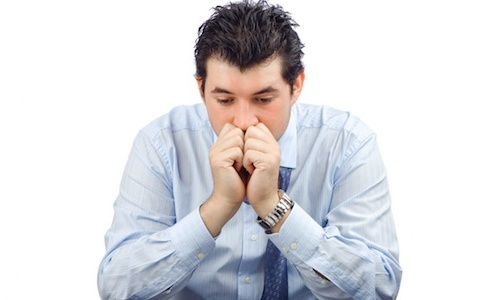disease Sometimes men have to face very unpleasant diseases affecting the holy of holies - the genitals. To similar pathologies is also epididymoorkhit - an inflammatory process that affects the testicles and their appendages. A similar disease occurs with the simultaneous infection of these organs. Statistics show that the men of the 20-40-year-old age group are most susceptible to this pathology.

How the pathology of the testicles
manifests The specialist usually does not have problems with the diagnosis of epididymochitis, since the pathology is distinguished by a bright complex of symptoms indicating the course of the infection process in the epididymis and testicle. The characteristic signs of such a pathology are:
- Elevated temperature of the whole body, as well as in the place of the lesion. At palpation, the inflamed side of the scrotum affected by the disease is hotter than the healthy half;
- An increase in the size of the epididymis and the testicle itself, when touching, there is a noticeable decrease in their mobility relative to each other, they become denser, and liquid begins to accumulate in the scrotum;
- Pain sensations in the affected scrotum, giving off in the spermatic cord and groin. When touched, the pain intensifies, and in the state of rest acquires a pulling-aching character;
- Chills;
- Swelling and local redness of the affected organ;
- In some cases pus begins to accumulate in the scrotum tissues, which eventually usually dry up on its own, but sometimes there is a need for surgical drainage of pus.
If epididymorchitis has a specific character, developing against a background of some other disease such as tuberculosis, syphilis, gonorrhea and others, then its clinical picture acquires some blurriness. The signs of the underlying disease are most pronounced, and the inflammation of the testis and the epididymis acquires a chronic development and proceeds almost asymptomatically:
- The pathology of tuberculous etiology is characterized by general weakness, subfebrile temperature, usually both testicles with appendages are affected, small stiffening appears in the scrotum, and with advanced disease in the testiclesformation of fistula begins;
- The gonorrheal form of the pathology is characterized by scrotal tenderness, increased fever, thickening of the duct and the appearance of minor discharge from the urethra.
Because the disease requires careful diagnosis. The urologist examines the patient, directs him to an ultrasound examination, studies anamnesis and appoints laboratory tests( taking blood, smear from the urethra, urine, etc.).Only after carrying out all the studies the doctor diagnoses and prescribes the necessary therapeutic course.
Why does epididymoorchitis occur
Inflammation of the testis and its epididymis can be specific( tuberculous, trichomonias, etc.) and nonspecific. Each clinical case is characterized by its causes and the pathogenesis of the disease. Disease infectious agents penetrate the testis and appendage through the blood or the vas deferens. Most often such agents are staphylococcal, gonococcal, streptococcal, tuberculosis pathogens. Thus, the gonorrheal form of the pathology arises from complications of gonorrheal inflammation of the urethra, its incorrect treatment and chronicization, in which the pathogen penetrates the vas deferens, and then into the epididymis and testis.
Warning! Inefficient conservative therapy can provoke the development of a severe abscess, which requires urgent surgical intervention aimed at draining the scrotum. If the abscess has acquired irreversible scales, then surgical removal of the inflamed organ will be required.
The most difficult to explain is tuberculous epididymoorchitis. Specialists do not fully understand the mechanism of the causative agent entering the scrotum cavity and the further origin of the infectious process. Therefore, with tuberculosis infection, the epididymis and testis are characterized by an isolated lesion. In the case of trichomoniasis epididymorchitis, the cause of the pathology is triggered trichomoniasis or its incorrect therapy.
In general, doctors distinguish the following etiological factors of pathology:
- Surgical intervention on the prostate;
- Complication after scrotal injury;
- Inflammatory diseases of low-tidal organs such as varicose, hemorrhoids, proctitis or paraproctitis;
- Viral pathologies transmitted through sexual contact;
- Significant low-temperature supercooling or overheating;
- Infectious diseases of the digestive organs;
- Torsion of epididymis or testis;
- Complicated course of inflammation of the urethra or prostate;
- Postoperative complication of endoscopy or catheterization of the urethra, bladder, etc.;
- Infectious diseases like the flu or sore throat;
- Frequent sexual arousal with erection without a subsequent eruption of the seed;
- Irrational therapy of infectious pathologies.
Inflammatory process begins with the penetration of microorganisms into the ducts or blood, then, against a background of weak immune defense, an infection develops. There is no categorical information that nonspecific epididymoorchitis develops due to the negative influence of a particular pathogen or a particular disease, since pathology develops in accordance with the individual characteristics of the organism and under the influence of a whole complex of processes.
Inflammation of this kind against the background of traditional tissue irritation develops in extremely rare cases. The probability of the development of pathology increases in the case of a sharp increase in physical strain, characteristic of an unusual kind of activity that the patient has not previously engaged in. Depending on the root cause and type of pathology, the urologist selects appropriate therapy and subsequent prevention of the disease.
Methods of treatment of
disease Treatment of pathology does not have a clear therapeutic scheme, since each case is unique and requires obligatory medical intervention. Nonspecific pathology involves a number of activities. For starters, the treatment is based on the use of powerful antibiotic drugs tetracycline, cephalosporin, fluoroquinolone and aminoglycoside series.
In addition, treatment requires a rigid diet and bed rest. On the scrotal area it is recommended to apply ice packs, during the day wear special underwear that fixes the scrotum properly( suspensions).In addition to antibiotic therapy, the reception of enzyme preparations that promote resorption of inflammatory foci is indicated. Early surgical interventions have significant advantages, because with their help, in almost all cases it is possible to save the fertile possibilities of men, but such treatment is only permissible in case of suppuration.

If we talk about specific varieties of pathology, then therapy depends on the type of pathogen that caused inflammation. The most difficult to treat form is tuberculous epididymoorkhitis. For him, a latent development is characteristic, so the patient gets to the doctor when pathology takes on heavy, neglected forms. For this type of disease is characterized by the presence of concomitant lesions of the prostate, bladder or kidney. The therapy scheme is of an anti-tuberculous nature, and the patient is necessarily placed in a hospital.
In general, epididymoorkhit therapy is aimed at arresting the inflammatory process, restoring all functions of the testicles and appendages, as well as resolving the inflammatory-infectious focus.
The disease of trichomonas etiology requires an integrated therapeutic approach. They resort to antibiotic therapy, immunomodulatory treatment, trichovaccination. At the final stage, general restorative therapy and strict control over the presence of trichomonas causative agents are suggested.
Inflammation of the epididymis and testis of gonococcal etiology is eliminated by adequate and correctly selected antibiotic therapy. After treatment, the patient again has to pass tests to confirm the absence of the pathogen. In this situation, the prevention of repeated exacerbations of the disease, in which the resistance of the gonococcal pathogen to antibiotic agents significantly increases, is important. Sealing around the appendage usually resolves after a couple of months, but thermal treatment will help to speed up this process( paraffinotherapy, diathermy, mud therapy, etc.).
In addition to taking antibiotics, antimicrobial, anti-inflammatory drugs, physiotherapeutic procedures like UHF or ultrasound are prescribed. Surgical therapy in practice is used quite rarely in the case of ineffectiveness of drug treatment or with a serious tuberculosis infection. Sometimes the operation is indicated to prevent the spread of the disease to the second testicle and appendage.
Important! During the entire therapeutic course, it is necessary to abandon alcohol production, sexual contacts, spicy food, physical overstrain, hypothermia, etc. Then the effectiveness of treatment increases significantly, and the risk of relapse fades.



